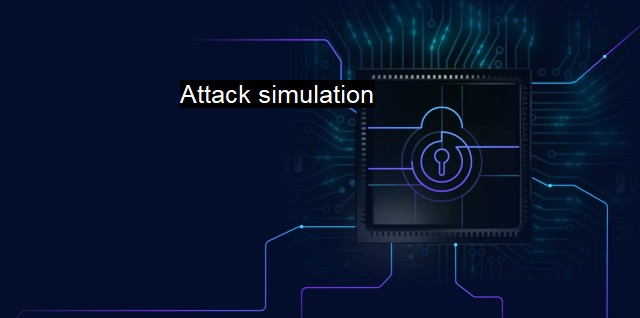What is Attack simulation?
Strengthening Cybersecurity with Simulation: Utilizing Attack Simulation Technology to Proactively Assess Network Security Measures
Attack simulation refers to the process of meticulously emulating malicious activities on an information system to evaluate its vulnerability and to find hidden security gaps. This method is usually employed in the realm of cybersecurity and antivirus application development to determine and reinforce weak spots and handle potential threats efficiently.Fundamentally, attack simulation serves as a proactive approach in constantly evolving cyberspace, as opposed to retroactive countermeasures that face the obvious downside of dealing with an issue after the fact. Attack simulation is rooted in penetration testing techniques where cyber defense systems are put to test, over and over again, using various approaches and attack vectors, to ensure no weaknesses remain unchecked.
The primary goal of attack simulation is to gain insight about a system's behaviour under different situations. Each attack scenario is designed to reproduce real-world cyberattacks, each attack having its own goal—whether it's data theft, bringing down entire networks, or hold hijacked systems for cryptocurrency ransoms. Thereby, this process provides insights into how the system reacts - denies or grants access, notifies system administrators, and what kind of remedial actions are subsequently taken, creating an overall picture of system robustness.
Attack enthusiasts determine security weak spots through standard scanning techniques and exploit them using virus or cyber threat emulations. It could be a widely known worm virus or a specifically programmed and camouflaged malware designed with the architecture of the system in mind. Antivirus mechanism designs also protect the system from both generic viruses and pinpointed attacks—illustrating, attack simulation applies to assessing antivirus performance.
In an attack simulation, vulnerability scanning includes a step-by-step process—beginning from endpoint tracing, where hackers might sneak into, then mapping the network field detailing all elements and establishing data flow patterns, distinguishing all possible databases of access. Each of these steps guides the process profoundly towards securing information system channels, identifying any soft spots, and eventually, fix them with assigned task forces.
Following the vulnerability scanning, ethical hackers question each point of possible data interaction by grouping systems for common security exposures. To illustrate, servers running the same software would receive similar threat vectors; thus, getting grouped permits analyzing threats comprehensively. Once vulnerabilities are located, ethical hackers exploit these vulnerabilities to see if an attack would be fatal—identifying how well the system or antivirus can safeguard against these breaches. This damage projection is critical in conveying the system's current security status and future preventions.
Introducing attack simulations does not mean you are making your network vulnerable. In any case, ethical hackers alone perform this procedure, and the attack simulation is entirely controlled; hence it does not allow a real attack to happen. The goal is to create alternative narratives of potential attack situations and rectify them before adversaries exploit them.
Attack simulation assists security stakeholders as it can reveal weaknesses in both cybersecurity and antivirus systems. These weak spots, if unchecked, can become a severe liability proving costly - not just financially, but adversely affecting the reputation of businesses when customer trust erodes because of lost or compromised data.
Importantly, boldly simulating attacks against one's information system is a defensive strategy - a quadruple check iteration. Vulnerability scanning visualizes the output of the attack simulation, directing effort into remediation, and prioritizing attention based on the severity and business-critical nature of vulnerabilities exposed. it presents an opportunity to train teams for real-world attack scenarios; ensuring the safeness of digital data should not cease on setting robust systems and state-of-the-art antivirus software, instead constant hardening of these mechanisms should be the norm. In entirety, attack simulation fosters a more robust cyber-immune system much needed in a digital world rife with cyber threats.

Attack simulation FAQs
What is an attack simulation?
An attack simulation is a cybersecurity practice that mimics the behavior of hackers to identify vulnerabilities in an organization's system. The goal is to test the effectiveness of the organization's security measures before a real attack occurs.Why do organizations need to simulate attacks?
Organizations need to simulate attacks to find weaknesses in their security measures and fix any vulnerabilities that could be exploited by real hackers. By conducting an attack simulation, organizations can identify the gaps in their security and improve their defenses to protect against real threats.What are the benefits of an attack simulation?
The benefits of attack simulation are that it helps organizations to assess their current security posture, identify vulnerabilities, and improve the overall security of their system. Conducting an attack simulation also helps build preparedness against real-world attacks and improves incident response capabilities.What types of attack simulations are there?
There are various types of attack simulations such as red teaming, blue teaming, purple teaming, and tabletop exercises. Red teaming involves ethical hacking to simulate a real-world attack, while blue teaming focuses on defending against the simulated attack. Purple teaming combines both red and blue teams to improve communication and collaboration. Tabletop exercises are simulations of cybersecurity incidents that allow organizations to test their response plans and evaluate their effectiveness.| | A | | | B | | | C | | | D | | | E | | | F | | | G | | | H | | | I | | | J | | | K | | | L | | | M | |
| | N | | | O | | | P | | | Q | | | R | | | S | | | T | | | U | | | V | | | W | | | X | | | Y | | | Z | |
| | 1 | | | 2 | | | 3 | | | 4 | | | 7 | | | 8 | | |||||||